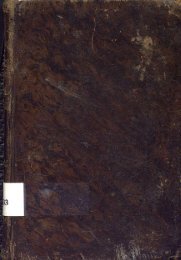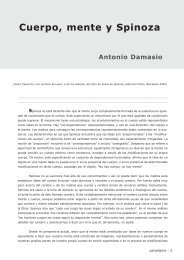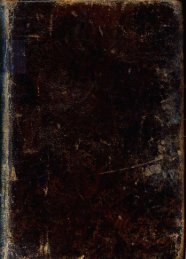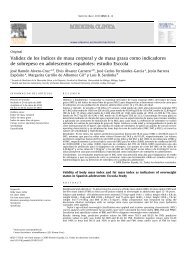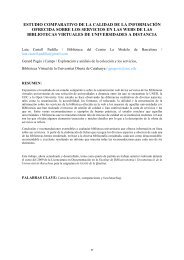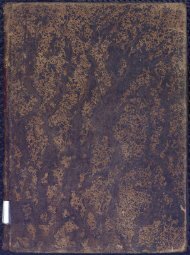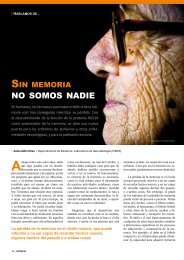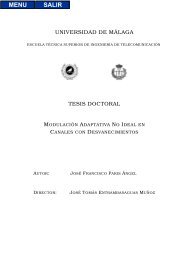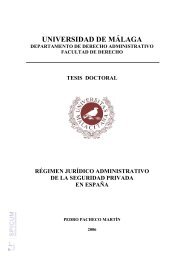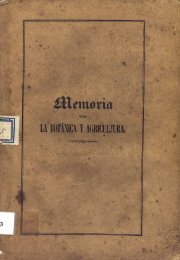Papel de las actividades superóxido dismutasa y catalasa en la ...
Papel de las actividades superóxido dismutasa y catalasa en la ...
Papel de las actividades superóxido dismutasa y catalasa en la ...
Create successful ePaper yourself
Turn your PDF publications into a flip-book with our unique Google optimized e-Paper software.
On the other hand, β-1,3-glucan from Eugl<strong>en</strong>a gracilis (BioChemika Fluka,<br />
Sigma) was used as a positive control. T<strong>en</strong> mg of this compound were dissolved<br />
according to the manufacturer instructions, and diluted in HBSS to achieve<br />
conc<strong>en</strong>trations of 10 mg ml -1 , 5 mg ml -1 , 2 mg ml -1 and 1 mg ml -1 .<br />
2.3. Inocu<strong>la</strong>tion with the polysaccharidic fraction and immunization assay<br />
Specim<strong>en</strong>s of S<strong>en</strong>egalese sole of 50 g mean weight were randomly separated into<br />
groups of 20 fish each, and stocked into six 2500 l tanks with recircu<strong>la</strong>ting, aerated<br />
seawater at 22 ºC, 35‰ salinity and fed daily with a commercial pellet diet (Skreeting,<br />
Skreeting, Trouw España, Nutreco, Burgos, Spain).<br />
Two groups of 20 fish were intraperitoneally injected with a dose of 500 μg of the<br />
extracellu<strong>la</strong>r polysaccharidic fraction from P. cru<strong>en</strong>tum per fish. Phagocytes from two<br />
groups of sole were sampled at 2 and 8 days from algal extract administration. One<br />
group of them was intraperitoneally inocu<strong>la</strong>ted with bacterin of P. damse<strong>la</strong>e subsp.<br />
piscicida, 24 h after the administration by intraperitoneal injection of the<br />
polyssachari<strong>de</strong>. The formalin-killed aqueous vaccine was prepared according to the<br />
following <strong>de</strong>scription. Briefly, the selected strain of P. damse<strong>la</strong>e subsp. piscicida<br />
iso<strong>la</strong>ted from diseased sole in Spain was cultured on TSAs, and one colony was<br />
transferred to one tube containing 5 ml of TSBs for 18 h at 22 ºC. After incubation at 22<br />
ºC for 18 h, an aliquot of the culture, 50 μl, was inocu<strong>la</strong>ted in a f<strong><strong>la</strong>s</strong>k containing 50 ml<br />
TSBs and incubated at 22 ºC for 18 h with continuous shaking. Wh<strong>en</strong> the culture<br />
achieved O.D.600 of 1.2, corresponding to 6 x 10 8 bacteria ml -1 , the cells were killed by<br />
addition of formal<strong>de</strong>hy<strong>de</strong> (1% final conc<strong>en</strong>tration) and incubated overnight. Sterility<br />
trials were performed by spreading an aliquot of the vaccine preparation on TSAs p<strong>la</strong>tes<br />
and incubating for 2 days at 22 ºC. The vaccine was administered by intraperitoneal<br />
injection (0.1 ml per fish). The other two groups of fish were used as the controls and<br />
phosphate buffer saline (PBS, pH 7.2) was inocu<strong>la</strong>ted instead of the algal<br />
polysacchari<strong>de</strong>. One of these groups was vaccinated with a bacterin against P. damse<strong>la</strong>e<br />
subsp. piscicida as <strong>de</strong>scribed above.<br />
5



